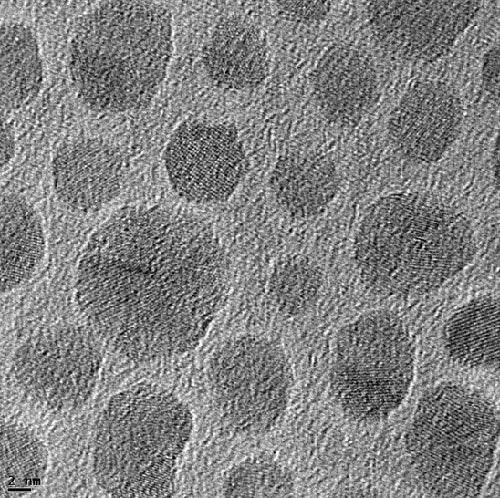Contributor: Tamal Mukherjee, Malvern-Aimil, Vadodadara, India
Ferrofluids are colloidal solutions of magnetic nanoparticles in a carrier fluid. The nanoparticles consist of a ferrimagnetic or ferromagnetic core that is stabilized to prevent aggregation. Industrial applications of magnetic nanoparticles cover a broad spectrum such as magnetic seals in motors, magnetic inks for bank cheques, magnetic recording media and biomedical applications such as magnetic resonance contrast media and therapeutic agents in cancer treatment [1,2].
Particles of ferromagnetic material below a critical particle size (<15 nm) consist of a single magnetic domain, i.e. a particle that is a state of uniform magnetization at any field. In almost all applications the preparation method of the nanomaterials represent one of the most important challenges that will determine the particle size and shape, the size distribution, the surface chemistry of the particles and consequently their magnetic properties [1,2].
TEM images of the nanoparticles (Figure 1) do not represent their actual arrangement when in suspension since the microstructure may be severely distorted on drying unless proper methodologies like lyophylization are adopted during sample preparation [3]. A more suitable technique for characterizing the size of ferrofluids is dynamic light scattering (DLS).

|
Dynamic light scattering is a non-invasive technique for measuring the size of nanoparticles in a dispersion. The technique measures the time-dependent fluctuations in the intensity of scattered light from a suspension of particles undergoing random, Brownian motion. Analysis of these intensity fluctuations allows for the determination of the diffusion coefficients, which in turn yield the particle size through the Stokes- Einstein equation [4-7].
Dynamic light scattering measurements of ferro nanoparticles were made on a Zetasizer Nano ZS. The system uses patented NIBS (Non Invasive Back Scatter) technology for size measurement and incorporates a 4mW 633nm wavelength laser. The scattered light was detected at an angle of 173˚.
Both coated and uncoated colloidal suspensions of ferric oxide nanoparticles were prepared in hexane. The z-average diameters and polydispersity index values were obtained from the cumulants analysis as defined in ISO [6]. The intensity particle size distributions were obtained by analyzing the correlation functions with the General Purpose algorithm which is based on a non-negative least squares fit [7,8].
The size results obtained for the uncoated ferric oxide nanoparticles dispersed in hexane are shown in Figure 2 and summarized in Table 1. These uncoated nanoparticles had a z-average diameter of 6nm and a polydispersity index value of 0.22.

|
Sample | z-Average Diameter (nm) | Polydispersity Index |
|---|---|---|
Uncoated ferric oxide | 5.7 | 0.22 |
Oleic acid coated ferric oxide | 85.7 | 0.42 |
These nanoparticles tended to form aggregates and thus sedimented over time due to high Van der Waal attractive forces. For suspension stability, magnetic nanoparticles are normally charged (positive or negative) or coated with substances like surfactants or long chain polymers. These surfactants form a shell on the particles and prevent aggregation thus increasing their shelf life. In this study oleic acid, a mono-unsaturated omega-9 fatty acid, was used for coating the particles. This coating resulted in an increase in the z-average diameter to 85 nm (Figure 3 and Table 1). The polydispersity index values of the coated particles was 0.42, implying that the distribution of size is relatively broad.

|
Dynamic light scattering is a non-invasive technique well suited for study of colloidal suspensions such as ferrofluids as the measurements are made on samples in their native environment. The mean diameter yielded by DLS measurements is influenced by the presence of large particles in the sample. This helps in determining the presence of agglomerates in the sample.
[1] C. Groß, K. Büscher, E. Romanus, C.A. Helm and W. Weitschies (2002) Euro. Cells and Materials 3, 163-166.
[2] J. Giri, P. Pradhanb, V. Somania, H. Chelawata, S. Chhatrea, R. Banerjeeb and D. Bahadur (2008) J. Magnetism and Magnetic Materials 320, 724-730.
[3] L. F. Gamarraa, G. E. S. Brito, W. M. Pontuschka, J. B. Mamani, C. A. Moreira-Filho and E. Amaro Jr. (2007) Brazilian J. Phys. 37, 1288-1291.
[4] Dahneke BE (1983), Measurement of suspended particles by quasi-elastic light scattering. Wiley, New York.
[5] R. Pecora (1985) Dynamic light scattering: Applications of photon correlation spectroscopy. Plenum Press, New York.
[6] International Standard ISO22412 (2008) Particle Size Analysis: Dynamic Light Scattering (DLS). International Organization for Standardization (ISO).
[7] C.L. Lawson and R.J. Hanson (1995), Solving Least Squares Problems. Society for Industrial and Applied Mathematics (SIAM), Philadelphia.
[8] S. Twomey (1997) Introduction to the Mathematics of Inversion of Remote Sensing and Indirect Measurements. Dover Publications, New York.